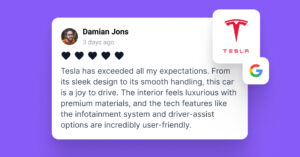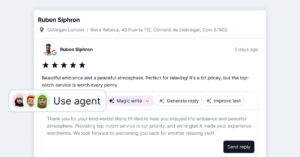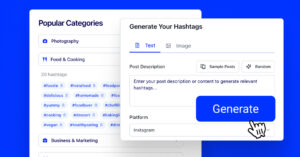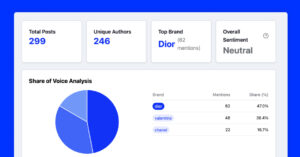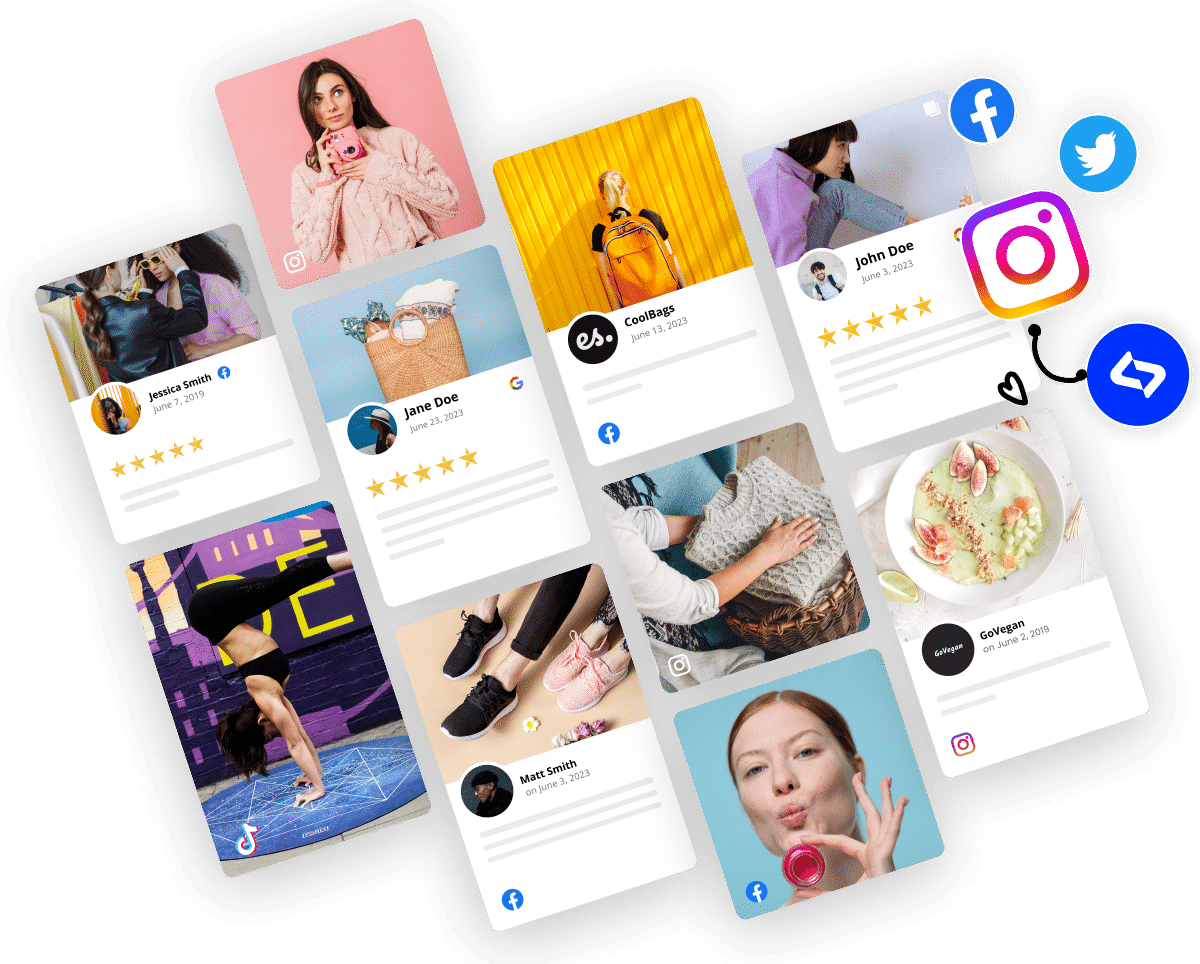Every marketer working for e-commerce brands knows that introducing UGC eCommerce content in marketing campaigns increases sales.
After all, user-generated content (UGC) drives authenticity and boosts consumer trust. Plus, once you leverage it, you can harness its power of social proof to increase your online presence, engagement, and sales.
FYI: You can embed user-generated content on your website automatically. Sign up now.

Generate social proof & user-generated content automatically
#1 UGC platform to automatically generate, save, analyze, and display UGC on your website.
So, let me introduce you to UGC, list its benefits for eCommerce companies, and show you how the best brands leverage user-generated content.
What is user-generated content (UGC)?
User-generated content (UGC) encompasses any form of content – reviews, photos, videos, social media posts – created by consumers instead of the actual brand.
Meaning of user-generated content
As you can see, when used well, UGC in eCommerce can have a massive impact on how the brand is perceived by its fans and the general public.
In fact, 92% of consumers trust organic, user-generated content more than traditional advertising, especially if it’s coming from people they know.
Imagine asking for an opinion about a product or service from someone who doesn’t have anything to gain by recommending any particular option.
That’s how UGC actually works: when shared on social media accounts without any prompts by eCommerce brands, it can either boost your bottom line significantly or warn potential buyers of spending money on your products and services. There’s no replacement for the authentic insights and customer experiences it offers!
Related:
Starting with user-generated content for e-commerce: 5 Steps
Integrating UGC’s social proof into your eCommerce website boosts customer trust and engagement. Here are five best practices for doing that effectively:
1. Aggregate existing user-generated content on social media with a UGC platform

Like a social media aggregator, a UGC platform can collect existing user-generated content shared on social media.
This means you can set up to aggregate mentions from Instagram, posts using a specific branded hashtag, or even Google reviews from actual customers using your products or services.
Once you aggregate content created by your customers, you can organize the UGC and tag the content in categories for better analysis and further leverage.
For example, if you use EmbedSocial to aggregate UGC, you can further search for the collected content and use the tagging functionality to organize it into categories, such as categories by product, categories by specific feature or advantage you offer, or even categories by certain media formats, like photos for Ads, videos for websites, etc.
Once you find the best content to leverage, it’s time to ask for the rights to use it.
2. Ask for rights to use the UGC

Next, once you have the user’s content, you can use a tool to ask for reviews. This usually is in the form of a comment or a direct message, stating the purpose of reusing the content and also offering additional incentives if needed.
Platforms like EmbedSocial provide UGC rights management functionality with the automatic sending of Instagram comments, such as the following:
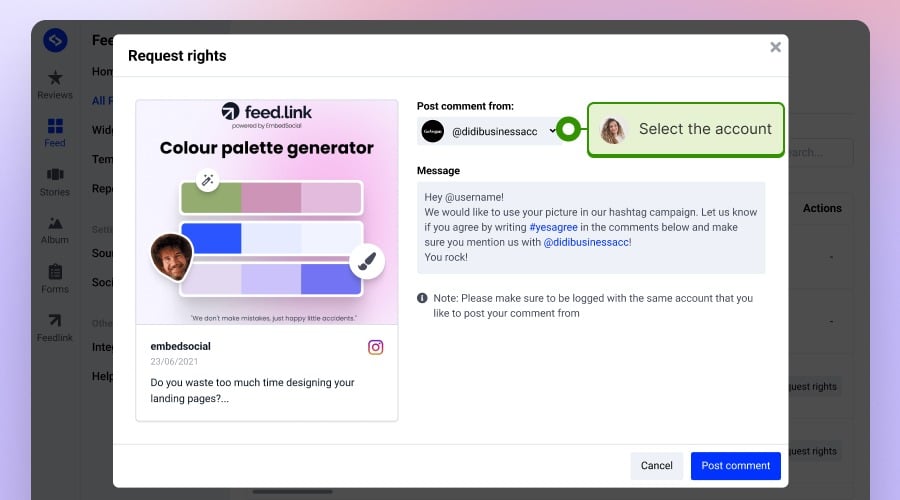
3. Encourage or incentivize UGC creation and sharing from customers
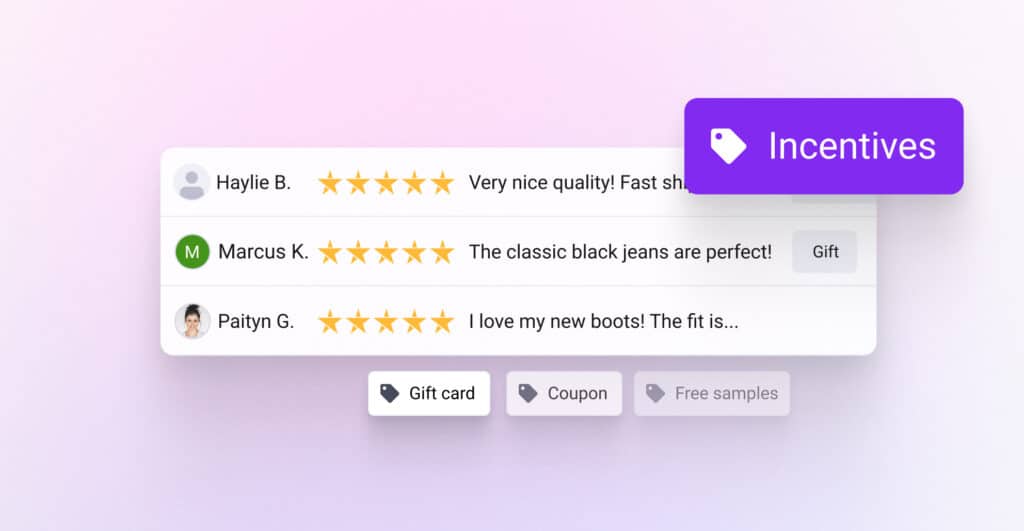
You need to be collecting UGC all the time, as you can use it for your marketing strategy whenever you need to. Therefore, actively encouraging customers to create and share content related to your products can significantly expand your UGC library.
There are several ways you can get authentic user-generated content:
- Send out follow-up emails or SMS requesting reviews or visual UGC;
- Organize hashtag campaigns that offer rewards for content;
- Incentivize reviews or creation of posts by offering discounts or swag;
- Check out your social media profiles for unprompted UGC;
- Embed a review collection form or QR codes on your website;
- Include clear calls-to-action (CTAs) on your pages and packaging;
- Get branded content with the help of influencers in your niche.
As you can see, there are many different ways to collect user-generated content, most of which do not require extra funds or time.
4. Showcase user-generated content on your e-shop
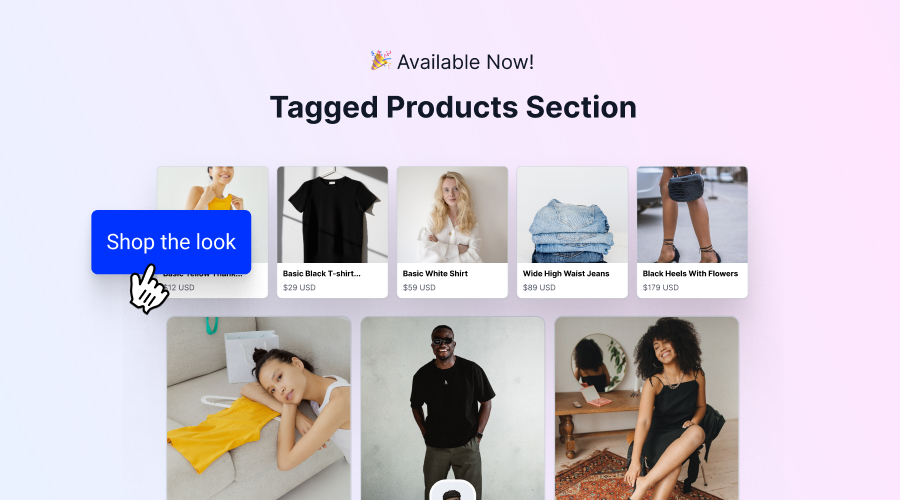
Once you get the rights and collect relevant content, you can leverage that user-generated content to sell more.
For instance, the best user-generated content examples show us that famous brands like Glossier, Calvin Klein, and ASOS regularly get and use content from their social media users. Don’t believe me? Just check out their social media handles.
To make shoppable UGC work towards more sales, you must integrate it into your website’s various sections, such as product pages, homepages, and dedicated review sections.
In practice, you must create a shoppable widget where your Instagram posts will be tagged with actual product information and links to checkout.
- Sign up for EmbedSocial
- Generate user-generated content from Instagram, Google or Facebook
- Create the shoppable widget and tag your products on the relevant content
- Get the embeddable widget code and paste it into your website.

You can add the shoppable widget on the product pages, where you can inspire potential buyers to see real-life applications of your products instead of just stock photos.
Furthermore, you can reuse this UGC widget to embed in email marketing campaigns and landing pages to drive higher engagement and conversion rates.
5. Monitor and respond to UGC eCommerce content
Last, you must actively monitor and respond to UGC to build a community around your brand and show that you value customer feedback. So, thank customers for their positive reviews and address any negative feedback whenever you can.
Reward and encourage customers to share content about your brand to foster loyalty and get them to continue creating and sharing free UGC you can use.
This interaction strengthens your relationship with existing customers and enhances your brand’s reputation by demonstrating a commitment to customer satisfaction.
That’s the best way to grow your eCommerce store nowadays!
Why is UGC important for e-commerce brands?
User-generated content (UGC) is essential for e-commerce and fashion brands because it offers authenticity, builds trust, and enhances customer engagement.
Here are the key benefits of incorporating UGC into your e-commerce website:
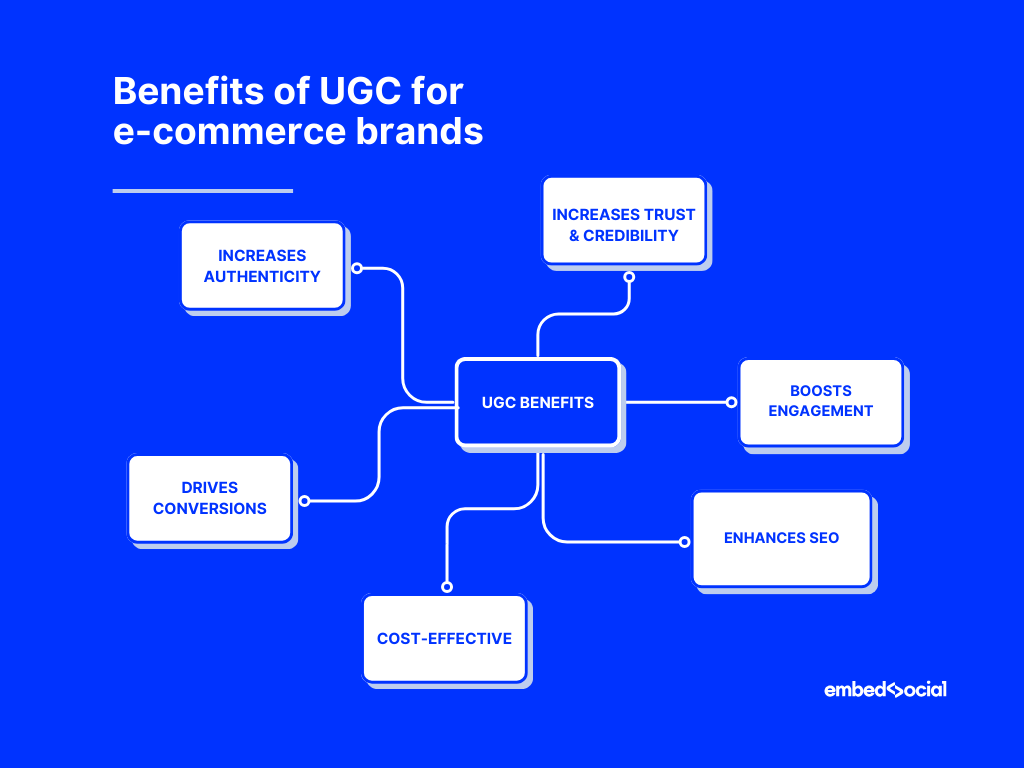
- Increases trust & credibility—consumers are more likely to trust content created by other consumers as it’s proof that real people use and enjoy your products;
- Boosts engagement—UGC e-commerce encourages interaction and engagement on social media platforms, leading to increased visibility and brand awareness;
- Enhances SEO—user-generated content can improve search engine rankings as it often includes relevant keywords and phrases organically;
- Cost-effective—leveraging UGC e-commerce reduces the need for expensive professional content creation, as customers provide valuable content for free;
- Drives conversions—user-generated content campaigns can significantly impact purchasing decisions. Displaying reviews can boost conversions by 270%;
- Increases authenticity—UGC adds a layer of authenticity to your brand, showcasing real-life experiences and honest and unprompted feedback. In fact, 75% of marketers claim that UGC makes brands more authentic.
Bottom line: UGC greatly impacts the consumer decision-making process by showing your customers they are making the right choice buying your products.
Here’s how The Influence Agency puts it:
“User-generated content is the word-of-mouth of the digital age. You can now decide if a product is worth your time, energy, and money based on the opinions and experiences of more people.”
The Influence Agency
7 best UGC marketing examples of eCommerce stores
Here are seven standout UGC marketing examples that show you how to effectively use UGC content to promote your e-commerce store, along with their benefits:
- Reviews help you stand out from the competition
- Interactive shopping experience through user-generated content
- Establishing a community that inspires users
- Social media hashtags encourage content sharing
- Customer testimonials build your brand trust
- DIY and how-to content engages creatively
- Product unboxing videos create excitement
1. Reviews help you stand out from the competition
Customer reviews provide authentic feedback for buyers to make informed decisions and enhance your store’s credibility to impact their purchasing decisions.
For example, Patagonia leverages detailed customer reviews on its product pages, allowing buyers to share their experiences and feedback. This transparency builds trust and provides potential customers with valuable insights into product performance and quality.
By showcasing authentic user reviews, Patagonia highlights its commitment to customer satisfaction and product excellence, ultimately driving higher engagement and sales, since they are the social proof that reassures and converts prospective buyers:
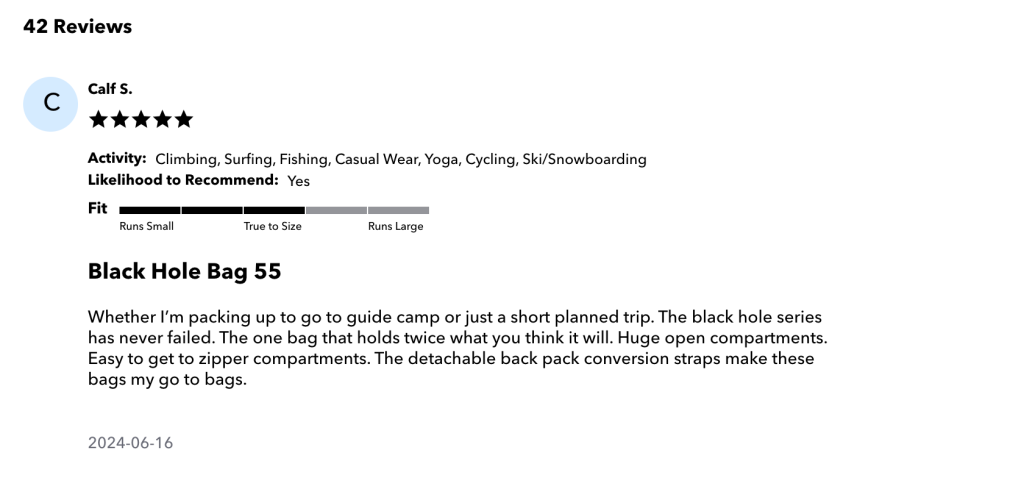
The benefits of showcasing reviews are substantial, as they build trust and credibility with your audience, which means that potential customers are more likely to believe the experiences of their peers over brand-generated content.
Moreover, positive reviews can lead to higher sales conversions, reassuring buyers about the product’s quality and reliability.
2. Desigual creates Interactive shopping experience through user-generated content
Shoppable Instagram feeds are a dynamic way to integrate user-generated content with e-commerce, allowing customers to shop directly from social media posts. Desigual leverages this feature to create an engaging shopping experience on their website.
The brand has incorporated a shoppable Instagram feed on its website, showcasing UGC from posts mentioning them. This feed allows customers to see real-life applications of Desigual products in unique and creative outfits shared by other customers.
By integrating shoppable posts, Desigual not only highlights the versatility and style of its products but also provides a seamless shopping experience. Customers can click on the featured images to purchase the items directly, making the shopping process engaging and interactive:
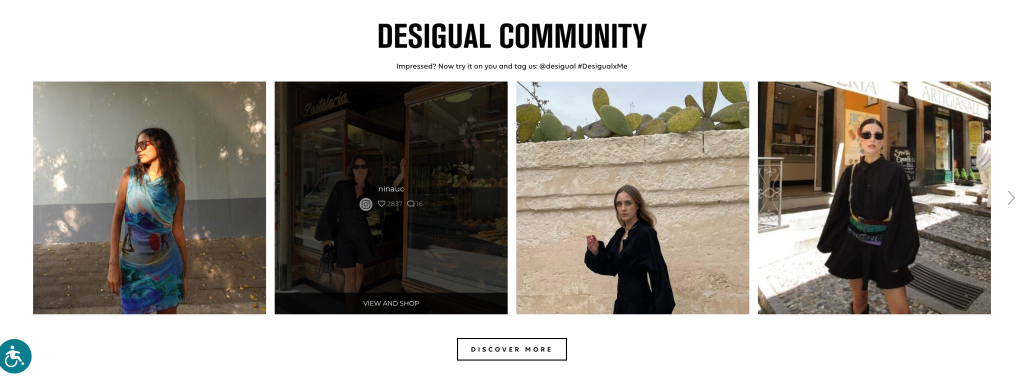
3. Establishing a community that inspires Nike customers
The Nike Running Club (NRC) community is a vibrant and supportive group of runners who share their experiences, achievements, and gear on social media platforms, particularly Instagram.
Using the hashtag #NikeRunningClub, members post photos and stories of their runs, showcasing Nike products in real-world settings. This UGC highlights the brand’s commitment to fostering a community of fitness enthusiasts and provides authentic endorsements of Nike’s running gear.
The shared experiences and motivation within the NRC community help to inspire and engage runners of all levels, as you can see below:

This active user participation builds a supportive community around the brand, which increases customer satisfaction and provides valuable feedback to the brand.
4. Social media hashtags encourage content sharing by Sephora customers
Creating and promoting unique hashtags encourages customers to share their own content featuring your products, increasing brand visibility and engagement.
For instance, Sephora—a leading beauty retailer—launched the #SephoraSquad campaign to build a community of brand ambassadors and generate authentic user-generated content. The campaign focused on inclusivity and personal stories shared by customers:

Sephora’s campaign successfully increased the brand’s visibility through authentic user-generated content, enhanced its community engagement and loyalty, and broadened its reach by leveraging the influence of micro and macro influencers.
This campaign successfully combined social media engagement, influencer marketing, and community building to promote Sephora’s products and brand values.
5. Customer testimonials like authentic Google reviews brand trust
Showcasing customer testimonials from satisfied clients on your website can enhance credibility and persuade potential buyers to trust your brand.
For example, Custom Clothing NY embeds Google reviews on its website, highlighting positive product and service experiences. These testimonials help build trust with new customers by showcasing genuine experiences and feedback from real users:
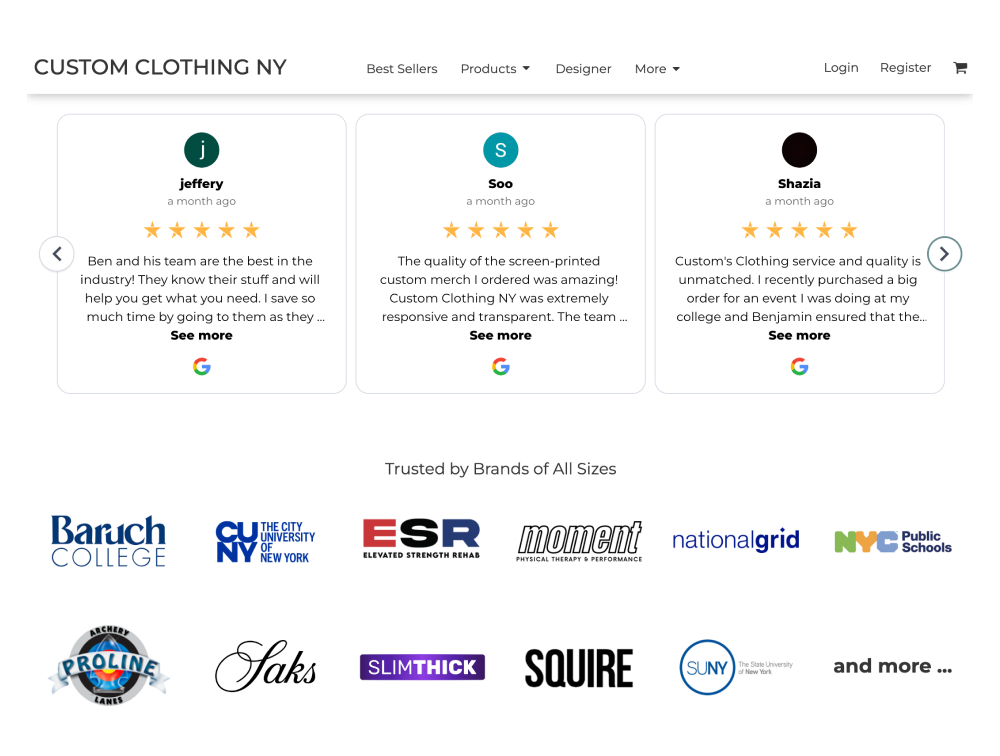
6. DIY and how-to content engages creatively
Encouraging customers to create DIY or how-to content with your products can lead to highly engaging and informative UGC.
IKEA promotes DIY and how-to content where customers share their creative furniture assembly and home decor ideas using IKEA products. This type of content showcases the versatility of IKEA products and empowers customers to personalize their spaces creatively.
For instance, this Instagram reel is of a user who transformed their IKEA furniture into a unique and stylish piece for their home. This type of content often goes viral, demonstrating the versatility and creativity that IKEA products inspire:
By highlighting these creative solutions, IKEA demonstrates the practical use of its products and engages with a community of customers who enjoy sharing their innovative ideas, which helps to position IKEA as a brand that values and fosters creativity.
7. Product unboxing videos create excitement
Unboxing videos are a popular form of UGC in which customers open new products. This type of content creates excitement and anticipation among potential buyers.
SKIMS is a famous brand that uses product unboxing videos to create excitement. These videos showcase a range of items, with the reviewer offering candid feedback on the fit, fabric, and overall quality of each piece. The try-on segment gives viewers a real sense of how the clothing fits and looks on a real person, helping potential customers make informed purchasing decisions.
Unboxing videos also allow potential buyers to examine the product more closely, helping them make informed purchasing decisions. Customers’ authenticity and enthusiasm in these videos can significantly boost brand loyalty and trust.
The impact of UGC on e-commerce marketing: 17 thought leaders’ opinions
Still unsure whether user-generated content will successfully boost your marketing efforts. Here’s what 17 industry experts have to say on the matter:
- Photo reviews boost e-commerce trust
- Testimonials validate health product efficacy
- Reddit UGC enhances brand engagement
- Instagram campaigns amplify brand presence
- UGC campaign increases sales and traffic
- Organic Instagram content drives qualified traffic
- Instagram hashtag grows brand community
- Surveys contribute to SEO success
- Contest sparks social media growth
- Polls foster Instagram community engagement
- Hashtag campaign lifts conversion rates
- Affiliate reviews drive traffic and sales
- Customer reviews enhance credibility and sales
- Social media shares showcase customer journeys
- Giveaways encourage family-style customer interaction
- Gardening contest validates product success
- Awnings UGC campaign encourages outdoor enjoyment
Photo reviews boost e-commerce trust
We’ve successfully integrated user-generated content by allowing customer feedback on product pages with photo reviews. Nowadays, it’s almost expected that e-commerce customers will look for reviews and feedback before making a purchase. The real game-changer, however, is the photos from customers. These images add substantial value for potential buyers. Not only do they enhance trust and credibility, but user-generated content photos can also foster a sense of community by encouraging customers to share their honest opinions and photos of their purchases with each other.
We’ve found great success in leveraging customer feedback on product pages with photo reviews. Take, for instance, our best-selling smartphones. All the necessary product details are provided at the top of the page, but it’s the customer reviews and images that really show how the phones suit different customers.
Sam Hickson, CEO, TG Wireless – Wholesale Cell Phones
Testimonials validate health product efficacy
As a company that focuses on health, testimonials are extremely important in order to guarantee that clients have faith in our product. Despite the fact that other companies might find it more beneficial to collaborate with influencers in order to reach a broader audience, it is of the utmost importance that we ensure our customers are aware that the product they buy is appropriate for them. As far as we are concerned, there is no more effective method of communicating this than by having members of our audience talk to one another about their specific experiences.
The application of knowledge and research that is supported by experts helps our customers understand how reputable we are. Nonetheless, there are still some customers who are skeptical. In light of the fact that some companies may exploit the confidence of their customers, this is to be expected.
By utilizing evaluations that were established by customers, we are able to make other individuals in that demographic feel more at ease trusting us. Even in fields unrelated to health and wellness, corporations have the potential to leverage this to build trust with their communities and feel more connected to them.
Jan Brandrup, CEO, Neurogan Health
Reddit UGC enhances brand engagement
User-generated content (UGC) can be a game-changer for e-commerce marketing, especially when leveraging highly engaging platforms like Reddit. One instance where UGC made a significant impact was when we encouraged our community to share their real-world experiences with our products in relevant subreddits. By fostering genuine conversations and testimonials, we were able to build trust and authenticity around our brand.
Reddit, with its diverse and engaged user base, offers a unique opportunity to cultivate a community that is primed to buy your products. We initiated discussions and AMA (Ask Me Anything) sessions where users could ask questions and share their experiences. This not only boosted engagement but also provided us with invaluable insights into customer preferences and pain points, which we used to refine our marketing strategies.
The outcomes of these UGC campaigns were remarkable. We saw a significant increase in website traffic and conversions, driven by the credibility and organic reach of user testimonials. Additionally, the community-driven content on Reddit helped improve our SEO rankings, making it easier for potential customers to find us through search engines. By tapping into the power of UGC on platforms like Reddit, we were able to create a more authentic and compelling narrative that resonated with our target audience.
Greg Davis, Founder, Azola Creative
Instagram campaigns amplify brand presence
User-generated content, or UGC, has significantly contributed to the growth and success of my business, Or & Zon. For instance, we implemented a UGC campaign called “#UnearthedTreasures” on Instagram, wherein customers shared images of their purchased items in their personal space. This not only amplified our brand’s online presence but also provided authentic and relatable lifestyle content for potential customers, showcasing our products in real-life environments.
Another successful instance was the “#ArtisanStories” campaign, where we encouraged our artisans themselves to share their own stories of craft development and creation on our platform. This UGC initiative not only strengthened our bond with our artisans but also allowed customers to connect with the creators of their purchased goods, enhancing their overall shopping experience. Over time, we saw a substantial increase in customer engagement, return purchases, and our brand’s word-of-mouth reputation.
Guillaume Drew, Founder & CEO, Or & Zon
UGC campaign increases sales and traffic
We have witnessed the remarkable power of user-generated content (UGC) in our e-commerce marketing efforts. One standout campaign involved encouraging parents to share photos of their little ones styling our products with the hashtag #KidsFashionFun. The response was overwhelming, with over 5,000 user-generated posts flooding social media platforms within a month.
The impact was undeniable; our brand visibility skyrocketed, leading to a substantial increase in website traffic and a noticeable rise in sales. The authenticity of UGC resonated with our audience, fostering a sense of community and trust around our brand. One parent even shared, “Seeing my child featured on your website made me feel like a part of something special.”
By leveraging user-generated content, we boosted our e-commerce presence and created meaningful connections with our customers. This experience solidified our belief in the power of authentic storytelling and the invaluable role of our community in shaping our brand’s success.
Nikhil Soni, Founder, The Tribe Kids
Organic Instagram content drives qualified traffic
For us, it’s the sales that have come from organic, user-generated content on Instagram. When customers independently share their positive experiences through videos, images, and reviews, it really carries immense credibility that paid influencer posts simply can’t match.
We’ve had cases where a happy client simply posts a short clip using one of our niche products and raves about the potency and flavor. With no coercion or incentives from us, that word-of-mouth gains us a lot of traction, and then we repost that to our community and proceed to hype up that product even more, maybe with a special or limited-time offer.
These types of natural, customer-created spotlights on our offerings always and consistently drive some of the highest qualified traffic to our website. People see their raw enthusiasm and just can’t help but want to try those products for themselves.
Dennis Sanders, Founder, Burning Daily
Instagram hashtag grows brand community
User-generated content (UGC) has increased social proof and authenticity, which has had a big influence on e-commerce marketing. A campaign was launched where customers shared their photos wearing branded dresses on Instagram. This authenticity boost made the photos relatable, building trust and convincing others to buy. The hashtag buzz created a fun community, driving brand awareness. The campaign resulted in a significant increase in website traffic and sales for the summer dress collection. UGC not only reached new audiences but also converted them into customers, demonstrating the power of authenticity and social proof.
Dhari Alabdulhadi, CTO and Founder, Ubuy Kuwait
Surveys contribute to SEO success
I produce a ton of content for my e-commerce brand, and not just in the form of optimizing category and individual product pages. We write a lot of blog content for the site to help expand our organic footprint, and soliciting user-generated content makes a huge difference in diversifying our efforts. By creating surveys on a wide variety of subjects relevant to our brand, we can reach out to our existing email base and get user-generated content that helps us continue to make huge SEO strides.
Steve DiMatteo, Owner, Cleveland Vintage Shirts
Contest sparks social media growth
We ran a contest where customers could submit creative photos or videos featuring our products for a chance to win a prize. The high volume of entries provided us with a wealth of high-quality, user-generated content that we could repurpose in our marketing efforts.
These contest submissions not only showcased our products in various creative contexts but also generated excitement and participation among our audience. The contest significantly increased our social media following and engagement, translating into higher sales.
Furthermore, the contest helped build a vibrant community of brand advocates who continue to share their enthusiasm for our products.
Brooke Webber, Head of Marketing, Ninja Patches
Polls foster Instagram community engagement
We focus on posting polls on our social-media handles, especially on Instagram, to boost interaction with our community. I think leveraging UGC not only promotes active user participation but also significantly increases engagement. Since we feature user-generated content on our Instagram, we can cultivate a sense of community that motivates users to connect more deeply with our brand.
An example of this strategy’s effectiveness is our recent campaign, in which we encouraged users to share photos of places where they stuck stickers they purchased from us. The resulting influx of authentic content showcased a diversity of experiences and significantly increased our engagement metrics. We then added it to content that we published on our website, which garnered even more views and shares.
David Rubie-Todd, Co-Founder & Marketing Head, Sticker It
Hashtag campaign lifts conversion rates
User-generated content (UGC) has been a game-changer for our marketing efforts. It provides authentic social proof, which is crucial for building trust with potential customers. One successful campaign we ran was inspired by the approach taken by brands like Iconic London and Glossier. We encouraged our customers to share photos and videos of themselves using our cut-resistant hockey gear with the hashtag #TitanTough on social media.
We featured the best UGC on our website and social media channels, creating a community feel and showing real-world applications of our products. This campaign not only boosted engagement but also resulted in a massive increase in social media followers and a substantial boost in conversion rates over three months. The authenticity and relatability of UGC helped build a stronger connection with our audience and enhanced their confidence in purchasing our products.
The authenticity of UGC helped bridge the gap between our brand and potential customers, creating a community feel and increasing their confidence in our products. For other e-commerce brands, encouraging customers to share their real-life experiences and prominently featuring this content can significantly boost engagement and sales.
Andries de Villiers, Founder, Titan BattleGear
Affiliate reviews drive traffic and sales
Implementing an affiliate program where affiliates shared their reviews and experiences with our products had a significant impact on our marketing. Affiliates created blog posts, videos, and social media content showcasing the benefits of our products.
Their authentic and detailed reviews resonated with their audiences, driving more traffic to our website. This increased visibility and credibility led to higher sales and conversions, as potential customers trusted the affiliates’ recommendations.
Roman Zrazhevskiy, Founder & CEO, MIRA Safety
Customer reviews enhance credibility and sales
User-generated content has significantly boosted our e-commerce marketing efforts through customer reviews. We encouraged our customers to leave detailed reviews about their experiences with our products. These authentic testimonials built trust and credibility among potential buyers, leading to increased sales. One notable outcome was an increase in conversion rates after prominently displaying these reviews on our website. The positive feedback also provided valuable insights for product improvements and customer satisfaction.
Sergey Taver, Marketing Manager, Precision Watches
Social media shares showcase customer journeys
One of our most successful UGC campaigns was our “Share Your Health Journey” initiative. We encouraged customers to post photos and stories about their health improvements using our supplements and well-being products on social media. This campaign increased our engagement rates and provided authentic testimonials that resonated with potential buyers. By showcasing real customer experiences, we built trust and relatability, leading to a substantial boost in sales.
Another successful UGC campaign was our “Healthy Recipes Contest.” We asked customers to share their favorite healthy recipes using our nutritional products. The response was phenomenal, with hundreds of creative and delicious entries. These recipes highlighted the versatility and quality of our products, creating buzz and excitement that traditional advertising couldn’t achieve. As a result, we saw an increase in website traffic and a rise in conversion rates during the campaign period.
We also leveraged UGC by encouraging customers to leave reviews and share their experiences using our health and wellness products. This strategy provided valuable feedback and created a community of loyal customers who felt connected to the brand. Authentic reviews and personal stories helped new customers make informed purchasing decisions, significantly reducing return rates and increasing overall customer satisfaction.
Sarah Gibson, Director, Proactive Healthcare
Giveaways encourage family-style customer interaction
We are a family business, and so a lot of our social media centers around that. However, we wanted to open things up a little and help all of our clients feel like part of the family, so to speak.
UGC has been really helpful for this, and one of the easiest and most effective ways we have promoted this is by using giveaways. We have so many wonderful testimonials from our customers. Sure, we share them, and if you wanted to search our socials or website, you would find them. However, we wanted to really highlight these.
So we started running giveaways where we persuade people to share their stories and positive experiences with our products. The prizes are always popular and appreciated, and we’ve actually gained new customers this way.
This has been a great way to boost engagement, bolster brand awareness, and encourage UGC. All the reviews, opinions, and experiences shared are so useful to us.
Not only are they great advertising, they also help us understand the consumer experience better. We read each and every comment and look for what’s not being said, as much as what is. These insights have proven invaluable.
Alexander Brandrup, Plant Ambassador, Founder, Neurogan
Gardening contest validates product success
An instance where user-generated content significantly impacted our e-commerce efforts was when a summer gardening contest encouraged customers to share photos of their cannabis plants grown using our products. The response was overwhelming, with hundreds of entries showcasing spectacular results. This campaign boosted our brand’s credibility, as potential customers could see the successes of fellow enthusiasts. Sales increased during the contest period, and engagement on our social media platforms saw a significant rise.
The authentic testimonials and visual proof provided by our customers were more persuasive than traditional advertising methods. The community felt more connected, creating a loyal customer base. My advice is to actively involve your customers and highlight their stories to build trust and drive sales.
Mike Drouin, Co-founder, Digital Marketing Director, Gardening & Home Improvement Expert, Reefertilizer
Awnings UGC campaign encourages outdoor enjoyment
It’s undeniable that there are many attentive e-commerce options available, right? This typically makes it difficult for e-commerce businesses to retain and onboard new customers. So, what’s that one thing that provides a great competitive edge, while also building authenticity? User-generated content, it is. It’s all about how actual customers leave perceptions about your product that get your target pulled towards you.
Picture this: would you rather purchase something with just a few average reviews, or its alternative slaying through UGCs? The UGC would feature how they benefited from the product for real, and that eventually builds trust. Besides, it also works as a brand builder because you’re providing something of value to the customers. Or simply said, a definite reason to come back! Because of such high conversions, we also tried to do something similar.
We provide awnings, so it is easy to ask users to upload content to their socials, enjoying the outside life under one of our creations. Generally, people are happy to do this, but you could also try an incentive like adding a discount to the next purchase for the most creative image shared using your business hashtag and tagging you in. It’s a bit of light-hearted fun, gets content created, and grows your audience.
Mike Falahee, President, Marygrove Awnings
Start with UGC for e-commerce today
All the tools you need to collect, manage, and display all the UGC you need for your user-generated content campaign are offered by UGC platforms.
For example, EmbedSocial is one of the best UGC platforms to cover the entire process, from collecting UGC to creating content as embeddable widgets.
Here are some of the features provided by these platforms:
- Collect reviews from every major review platform.
- Connect to and pull UGC from every popular social media platform, such as Instagram mentions
- Create and send out review collection forms
- Comprehensive link-in-bio tool and micro-website builder
- Various analysis and social media monitoring tools
- AI-powered features to get, summarize, and reply to feedback
- Tag your e-commerce product posts with checkout links
- Customizability options for embeddable widgets without coding knowledge
To inspire, check the Instagram shoppable widget and get started with UGC for eCommerce today:
Sign up now to get the shoppable widget for your eCommerce store.
Conclusion: E-commerce brands need user-generated content campaigns to succeed!
At the end of the day, UGC greatly enhances the trust and credibility of your e-commerce brand as it covers real-life cases of use for your products and services.
So you can imagine how consumers trust UGC more than traditional advertising, especially visual UGC enhanced with photos and videos, which can significantly boost engagement for e-commerce brands by showcasing products in relatable situations.
For that reason, actively encourage your customers to share their experiences and offer incentives like discounts or loyalty points to collect more UGC.
Plus, as an e-commerce brand, you must monitor and respond to user-generated content to build a community around your brand—something that comprehensive platforms like EmbedSocial can help you with, as they ease the entire process of UGC management.
All of the above will help you create the perfect UGC campaigns, thus showing your loyal customers that you value all the branded hashtag content they provide you with—there’s no better way to foster loyalty and encourage ongoing UGC creation.
FYI: You can embed user-generated content on your website automatically. Sign up now.
FAQs about UGC for eCommerce
What does UGC stand for?
UGC stands for user-generated content, and it refers to any form of content (both written and visual) created by consumers rather than the brand itself.
What is UGC in eCommerce?
In e-commerce, UGC encompasses all the content related to a brand or its products that customers create and share, which includes everything from product reviews to unboxing videos, photos of the product in use, and social media posts.
Do brands pay for UGC?
Brands do not typically pay for UGC as it must be created organically by customers to retain its authenticity and originality. However, they may still incentivize the creation of UGC by offering rewards such as discounts, loyalty points, or entry into contests.

